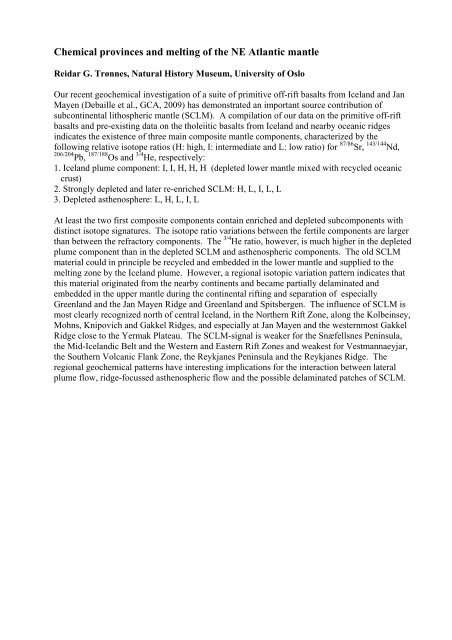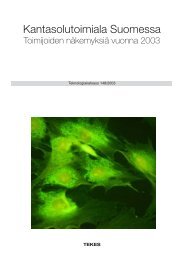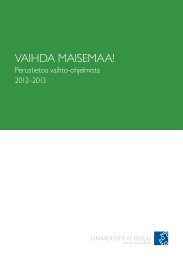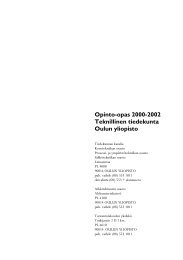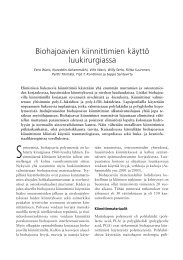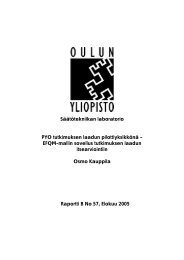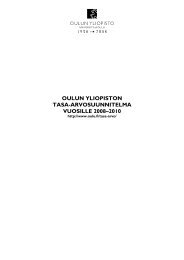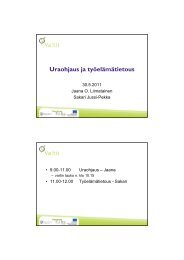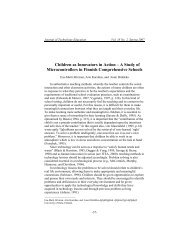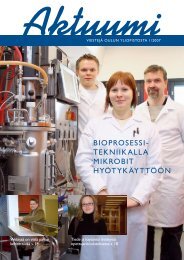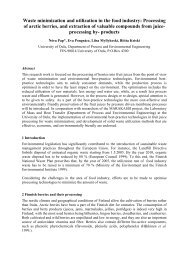Meeting programme - Oulu
Meeting programme - Oulu
Meeting programme - Oulu
You also want an ePaper? Increase the reach of your titles
YUMPU automatically turns print PDFs into web optimized ePapers that Google loves.
Chemical provinces and melting of the NE Atlantic mantle<br />
Reidar G. Trønnes, Natural History Museum, University of Oslo<br />
Our recent geochemical investigation of a suite of primitive off-rift basalts from Iceland and Jan<br />
Mayen (Debaille et al., GCA, 2009) has demonstrated an important source contribution of<br />
subcontinental lithospheric mantle (SCLM). A compilation of our data on the primitive off-rift<br />
basalts and pre-existing data on the tholeiitic basalts from Iceland and nearby oceanic ridges<br />
indicates the existence of three main composite mantle components, characterized by the<br />
following relative isotope ratios (H: high, I: intermediate and L: low ratio) for 87/86 Sr, 143/144 Nd,<br />
206/204 Pb, 187/188 Os and 3/4 He, respectively:<br />
1. Iceland plume component: I, I, H, H, H (depleted lower mantle mixed with recycled oceanic<br />
crust)<br />
2. Strongly depleted and later re-enriched SCLM: H, L, I, L, L<br />
3. Depleted asthenosphere: L, H, L, I, L<br />
At least the two first composite components contain enriched and depleted subcomponents with<br />
distinct isotope signatures. The isotope ratio variations between the fertile components are larger<br />
than between the refractory components. The 3/4 He ratio, however, is much higher in the depleted<br />
plume component than in the depleted SCLM and asthenospheric components. The old SCLM<br />
material could in principle be recycled and embedded in the lower mantle and supplied to the<br />
melting zone by the Iceland plume. However, a regional isotopic variation pattern indicates that<br />
this material originated from the nearby continents and became partially delaminated and<br />
embedded in the upper mantle during the continental rifting and separation of especially<br />
Greenland and the Jan Mayen Ridge and Greenland and Spitsbergen. The influence of SCLM is<br />
most clearly recognized north of central Iceland, in the Northern Rift Zone, along the Kolbeinsey,<br />
Mohns, Knipovich and Gakkel Ridges, and especially at Jan Mayen and the westernmost Gakkel<br />
Ridge close to the Yermak Plateau. The SCLM-signal is weaker for the Snæfellsnes Peninsula,<br />
the Mid-Icelandic Belt and the Western and Eastern Rift Zones and weakest for Vestmannaeyjar,<br />
the Southern Volcanic Flank Zone, the Reykjanes Peninsula and the Reykjanes Ridge. The<br />
regional geochemical patterns have interesting implications for the interaction between lateral<br />
plume flow, ridge-focussed asthenospheric flow and the possible delaminated patches of SCLM.


